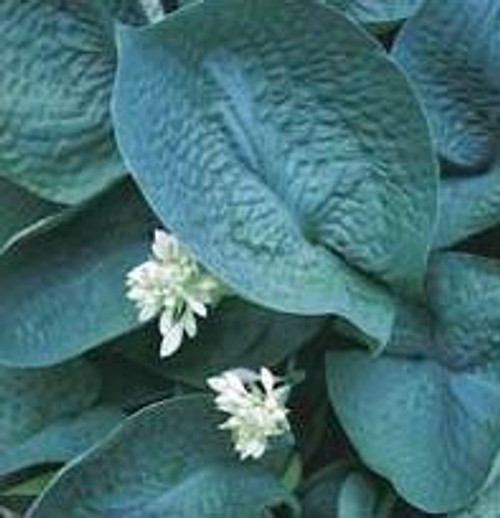Product Description
'Abiqua Drinking Gourd' Hosta (20)ct Flat
Medium to Large.
Dark blue-green, seersuckered leaves with heavy substance display a unique cupped form up to 3" deep.
Demonstrates good slug resistance. White flowers appear just above the foliage on 22" scapes in early summer.
Tokudama x sieboldiana seedling.
Height: 18.0 Inches
Spread: 36 Inches
Scape Height: 22 Inches
Hardiness Zones: 3,4,5,6,7,8,9
Flower Color: White shades
Foliage Color: Green shades
Part Shade (4-6 hrs. Direct Sun) to Full Shade (< 4 hrs. Direct Sun)
Average to Consistent Water Needs
Average to Fertile Soil Quality
Bloomtime: Early Summer
Attracts Hummingbirds
Growth Rate: Medium
Border Plant, Container, Cut Foliage, Easy To Grow, Mass Planting, Specimen, Focal Point
Hosta 'Abiqua Drinking Gourd' is a unique and eye-catching hosta cultivar known for its deeply cupped, blue-green leaves and excellent slug resistance. It adds a bold and textural element to shade gardens. Here is a closer look at its key features:
Appearance:
- Deeply Cupped Leaves: The most distinctive feature of 'Abiqua Drinking Gourd' is its thick, deeply cupped, dark blue-green leaves. The leaves have a seersuckered texture and can reach up to 8 inches long. The cupping is so pronounced that the leaves can hold water, resembling drinking gourds.
- Slug Resistance: This hosta exhibits good resistance to slugs, a common pest for hostas.
- White Flowers: In early summer, it produces white flowers on 22-inch scapes (stalks) that rise just above the foliage.
Growing Conditions:
- Shade: Thrives in partial to full shade. It prefers some shade during the hottest part of the day.
- Moist Soil: Prefers moist, well-drained soil that is rich in organic matter.
- Hardiness Zones: Suitable for USDA hardiness zones 3-9, making it a versatile choice for many gardeners.
Care:
- Watering: Water regularly, especially during dry periods, to keep the soil consistently moist.
- Fertilizing: Fertilize in spring with a balanced fertilizer to promote healthy growth.
- Mulching: Mulching around the plant helps retain moisture and suppress weeds.
- Dividing: Divide clumps every few years in spring or fall to maintain vigor.
Uses:
- Shade Gardens: Adds a bold and textural element to shade gardens.
- Borders: Can be used as a border plant or edging for pathways.
- Specimen Plant: Its unique form makes it a great choice for a specimen plant in a container or a special spot in the garden.
- Woodland Gardens: Adds interest and texture to woodland gardens.
Additional Information:
- Large Size: 'Abiqua Drinking Gourd' is a medium to large hosta, reaching about 18 inches tall and 36 inches wide.
- Award Winner: It has received several awards, including the American Hosta Society Best Green Hosta in a Garden Award and the Royal Horticultural Society's Award of Garden Merit.
If you are looking for a unique and eye-catching hosta with deeply cupped leaves and excellent slug resistance, Hosta 'Abiqua Drinking Gourd' is an excellent choice. It is a bold and beautiful addition to any shade garden.
Other Details
The most important part of the plant is its root system. Healthy roots are the foundation of a healthy, vibrant plant. The type of plug container used is based on the specific needs of the plants. Perennials offered as bare root traditionally perform better when planted as bare root.Planted in a specialized mix, potted plants have well established root systems. Top growth stage will vary depending on the current life cycle and time of year when shipped. In Winter and early Spring dormant plants may be shipped. Dormant plants may be planted right away, even before the last frost date.
Most bare root varieties are field grown for at least one season, though Hemerocallis and Hosta are grown for two seasons. The bulk of the soil is removed during the harvesting process and the tops of most varieties are trimmed back to the crown. They are graded, packed in shredded aspen or sphagnum moss and stored in freezers until ready to be shipped.
See our Container Sizes and Bare Root Perennials pages for more information.
Plant information and care is provided in the Overview section, Plant Genus Page and general information is provided in the Planting Care & Guides. Additional questions can be asked on each Plant page.
Plant Spacing: Using the maximum mature spread or width of a plant to guide spacing, ensures space to grow to full size. To fill an area sooner, plant them closer together. Just remember, future thinning or transplanting may be needed.
Water: Keep a close eye on newly planted perennials, especially throughout the first growing year. Most early plant loss is due to too much or too little water!























